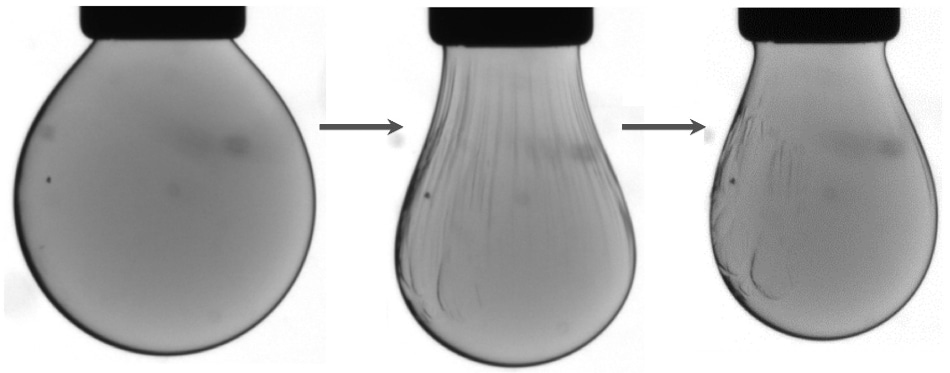Aug 9 2018
A team led by researchers at the U.S. Department of Energy’s Lawrence Berkeley National Laboratory (Berkeley Lab) found a method to make a liquid-like state act more like a solid, and then to reverse the process.
 Nanocrystals within a liquid droplet that is injected into an oily solution (left) are chemically compressed into a solid-like “jammed” 2D state (middle)—which causes wrinkles to form on the surface of the droplet—and then revert to a relaxed, liquid-like state (right) in which the wrinkles smooth out. (Credit: Berkeley Lab)
Nanocrystals within a liquid droplet that is injected into an oily solution (left) are chemically compressed into a solid-like “jammed” 2D state (middle)—which causes wrinkles to form on the surface of the droplet—and then revert to a relaxed, liquid-like state (right) in which the wrinkles smooth out. (Credit: Berkeley Lab)
They added a droplet of a liquid containing iron oxide nanocrystals into an oily liquid having minute polymer strands.
They discovered that a chemical additive in the droplet can compete with the polymer—like a miniature tug of war—on nanoparticles at the intersection of the liquids.
They were able to make the nanoparticles assembled here to jam, causing it to act like a solid, and then to unjam and return to a liquid-like state by the competitive push-pull action of the additive and the polymer.
“The ability to move between these jammed and unjammed states has implications for developing all-liquid electronics, and for interacting with cells and controlling cellular functions,” said Tom Russell of Berkeley Lab’s Materials Sciences Division, who co-led the research with Brett Helms, a staff scientist at Berkeley Lab’s Molecular Foundry. The Molecular Foundry is a DOE Office of Science User Facility that dedicated to nanoscience research.
We were able to watch these droplets undergo these phase transformations in real time. Seeing is believing. We are looking at the mechanical properties of a 2D liquid and a 2D solid.
Brett Helms, Staff Scientist, Berkeley Lab’s Molecular Foundry
The results were reported online in the August 3rd issue of Science Advances.
They observed this movement between the two states just by looking at variations in the shape of the droplet. The changes offer information about the tension on the droplet’s surface, similar to watching the surface of an inflating or deflating balloon.
They employed an atomic force microscope, which functions like a miniature record player needle to move over the droplet’s surface to measure its mechanical properties.
The newest study is based on earlier research by Russell and Helms, visiting researchers, and others in Berkeley Lab’s Materials Sciences Division and at the Molecular Foundry to shape complex, all-liquid 3D structures by injecting threads of water into silicone oil.
While changing liquid states to solid states normally involve temperature alterations, in this new study, scientists instead added a chemical compound called a ligand that bonds to the surface of the nanoparticles in a particular way.
We demonstrated not only that we could take these 2D materials and undergo this transition from a solid to a liquid but also control the rate at which this happens through the use of a ligand at a defined concentration.
Brett Helms
At greater concentrations of ligand, the assemblage of nanocrystals relaxed more rapidly from a jammed state to an unjammed state.
Scientists also learned that they could control the properties of the liquid droplets in the oil solution by applying a magnetic field—the field can deform the droplet by attracting the iron-containing nanocrystals, for instance, and alter the tension at the surface of the droplets.
Discovering new ways to regulate such all-liquid systems could be beneficial for interacting with living systems, Helms said, such as bacteria or cells.
Essentially you could have the ability to communicate with them – move them where you want them to go, or move electrons or ions to them. Being able to access this by simple inputs is the value of this.
Tom Russell
The research is also beneficial for revealing fundamental mechanical and chemical properties of the nanocrystals themselves.
Helms explained that the new study’s simplicity should help others to learn from and expand the research. “We didn’t use anything complicated here. Our goal is to show that anybody can do this. It provides clever insight about nanochemistry at interfaces. It also shows us that chemical systems can be designed with tailored structures and properties in the time domain as well as in the spatial domain.”
Future research could concentrate on how to miniaturize the liquid structures for biological applications or for energy applications in 2D materials, Russell observed.
“The beauty in this work is the manipulation of nanoscale elements, just billionths of an inch in size, into larger constructs that respond and adapt to their environment or to specific triggers,” he said.
Other scientists taking part in the research were from Berkeley Lab’s Molecular Foundry and Materials Sciences Division, the UC Berkeley, and the University of Massachusetts Amherst. The research was aided by the U.S. Department of Energy’s Office of Science.